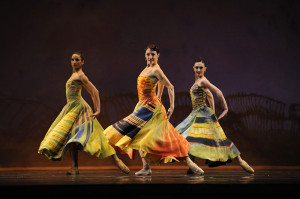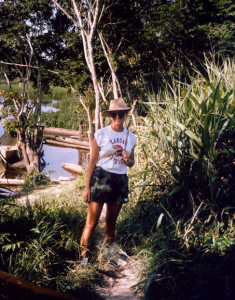
San Francisco Ballet dancers in Caniparoli’s “Lambarena”
I never thought I’d get the chance to mention San Francisco Ballet and my two-year African experience in the same breath, much less blog about it, but here we are. Tuesday night I attended San Francisco Ballet’s 2015 season opener, a program that featuring Serenade, RAkU and Lambarena. Balanchine’s Serenade has been praised, reviewed, analyzed, waxed lyrically over since its premier in 1935, so I’ll say no more. RAkU, choreographed in 2011 by Yuri Possokhov, I loved, even more than I’d expected to. For Val Caniparoli’s 1995 Lambarena, it was the reverse. Not that it was bad in any way, mind you. It was great: spirited, joyful, beautifully choreographed, impressively performed. It’s just that it felt Caribbean, Brazilian, when I wanted more Africa, more Lambaréné. Can you blame me? I lived there.

My friend Missy, accompanying me Tuesday night, loved Lambarena. Most people do. The music is a fusion of Bach and African traditional music (arranged by Pierre Akendengue and Hughes de Courson) and the choreography is accessible: classical with African movements incorporated (with consultation by African dance experts Zakariya Sao Diouf and Naomi Gedo Washington). Here’s an excerpt.
Now, Lambaréné, as in the Gabonese city. Oh, to capture what was so powerful to witness, living there in my early twenties. They didn’t have ballet classes, even in Libreville, the capital city, cosmopolitan and French-oriented as it was. To the Gabonese, the term ballet meant a performance, a play with music and dance. There was no studio for me to go to and pay to dance. Dance was outdoors, and free.
You danced at friends’ houses; you danced at outdoor gatherings. You danced in church, you danced in bars, you danced any time someone put on the right music. Dancer that I was, I still couldn’t move like the Gabonese. Something in me was too rigid and had to break down, not just physically but psychologically. Call it a ballet dancer genetic defect. The Gabonese moved with a freedom within their bodies I couldn’t even imagine. Relaxed energy flowed from all parts of their body: the legs, the torso, the arms. Sometimes the movement would be so small, just this gentle, rhythmic shifting from one foot to another. And, like most white people, I couldn’t duplicate it.
There seemed to be a different on/off mentality, to boot. For me, dance was like a light switch. Like jumping into a swimming pool versus standing on the side. No middle ground. That wasn’t the case with Africans. An innate flexibility in the hips (when you see toddlers learning to dance in tandem with learning to walk, you understand the source of this intuitive movement) allowed them to have a more fluid stance. A micro-bend in the knees contributed too. Once I caught on to these two un-ballet-like adjustments, practicing them over and over, I learned to find that middle ground, at least as much as my white-girl, ballet dancer’s body was going to find.
On YouTube I found a music video that’s the perfect example of African dance found in everyday life, even (especially?) amid an argument. Wow, a different kind of pas de deux. A fun fact: the singer, Patience Dabney, was once First Lady of Gabon, married for thirty years to [former] president Omar Bongo, before taking on a new persona as a professional singer and performer. She rocks. Here’s the flavor of Africa, of Gabon, that I’d been seeking. Ahh….
Back to Lambarena. Here’s what I had to say in my Bachtrack review of the night’s performance: http://bachtrack.com/22/296/view/7010. A shout-out to the dancers I found to be especially good in the ballet: Lorena Feijoo, Kimberly Braylock, Ellen Rose Hummel (the three dancers featured in the above photo), Daniel Deivison-Oliveira and Joseph Walsh (a new principal this season, coming from Houston Ballet). Really nice job, all of you, as well as the dancers I didn’t mention.
And RAkU, which left such a powerful impression on me. The set, costumes, gorgeous music composed by Shinji Eshima (a longtime musician with the San Francisco Ballet Orchestra), the whole phenomenal cast. Great job, Gaetano Amico, Steven Morse, Sean Orza, Myles Thatcher as the four warriors who opened the ballet with such power and energy. Yuan Yuan Tan, as the princess, Carlos Quenedit as the prince, Pascal Molat as the psychopathic monk intent on destroying both the temple and the princess. What a riveting performance by all of you. What a ballet. What a great night of great dance.

**
PS: A humorous aside. Spell Check kept insisting that, instead of Lambarena, I surely wanted lamb arena. Since then, I’ve been visualizing lambs in an arena. It makes me smile.
PPS: The Backtrack review covers both Serenade and RAkU more extensively, so give it a peek if you’d like to learn more. http://bachtrack.com/22/296/view/7010

African dance vs. ballet: I remember how difficult I found the transition from ballet to flamenco. My body had to learn a completely new language.
Oh, I could see that perfectly, Paulina! By the way, at my ballet class this past Tues, I noticed that they just added a beginning flamenco class to their schedule. Cool, huh? : )
I find African dance undignified. It typically lacks grace. The movements are often contorted and visually awkward-looking, as seen in the first image here. The movements are often goofy-looking, silly, clownish, comic. Embarrassing. Imitating a strutting rooster.
Is there any African dance remotely similar to waltzing? Is there any slow-paced traditional African music at all? Everything is so manic and high energy. ( It isn’t relaxing to listen to. ) Often the dance is crazed, a cacophony of headache inducing noise that is in your face, aggressive, violent. Or highly sexualized as with “twerking” and “daggering”.
African dance is unsophisticated.
I can’t think of a single thing I like about African culture or African American culture. I find both off-putting.
Well, that’s certainly a spirited opinion, Jason! I always welcome comments, even when they don’t echo my own opinion, and I hope others enjoy hearing your perspective too.
I guess the “me before Africa” would agree with you on your thoughts that it looks undignified, lacks grace. Now I’m utterly enthralled by it because of my two years in provincial Africa, and the long dip into the culture. I watch them move and I know I’d never be capable of that, as a Midwestern-raised suburban white girl.
Imagine what they thought of ME, as I did ballet in my home (I could hear them outside my home sometimes, trying to peer in) and the fact that I played classical music on my cassette player 90% of the time. I’m with you there: everything about African music is manic and high energy. I found no equivalent to classical music, or the way it soothed me deep inside. Unsurprising that I kept classical music close to my heart, and unsurprising that, now back in the U.S, I keep African music close to my heart as a memory of those two years.